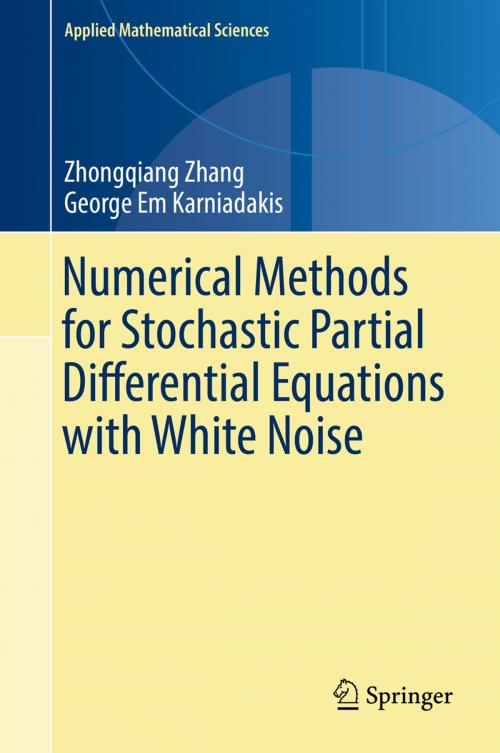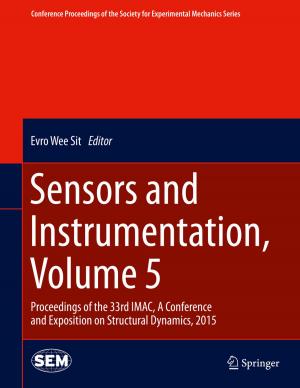Numerical Methods for Stochastic Partial Differential Equations with White Noise
Nonfiction, Science & Nature, Mathematics, Number Systems, Statistics| Author: | Zhongqiang Zhang, George Em Karniadakis | ISBN: | 9783319575117 |
| Publisher: | Springer International Publishing | Publication: | September 1, 2017 |
| Imprint: | Springer | Language: | English |
| Author: | Zhongqiang Zhang, George Em Karniadakis |
| ISBN: | 9783319575117 |
| Publisher: | Springer International Publishing |
| Publication: | September 1, 2017 |
| Imprint: | Springer |
| Language: | English |
This book covers numerical methods for stochastic partial differential equations with white noise using the framework of Wong-Zakai approximation. The book begins with some motivational and background material in the introductory chapters and is divided into three parts. Part I covers numerical stochastic ordinary differential equations. Here the authors start with numerical methods for SDEs with delay using the Wong-Zakai approximation and finite difference in time. Part II covers temporal white noise. Here the authors consider SPDEs as PDEs driven by white noise, where discretization of white noise (Brownian motion) leads to PDEs with smooth noise, which can then be treated by numerical methods for PDEs. In this part, recursive algorithms based on Wiener chaos expansion and stochastic collocation methods are presented for linear stochastic advection-diffusion-reaction equations. In addition, stochastic Euler equations are exploited as an application of stochastic collocation methods, where a numerical comparison with other integration methods in random space is made. Part III covers spatial white noise. Here the authors discuss numerical methods for nonlinear elliptic equations as well as other equations with additive noise. Numerical methods for SPDEs with multiplicative noise are also discussed using the Wiener chaos expansion method. In addition, some SPDEs driven by non-Gaussian white noise are discussed and some model reduction methods (based on Wick-Malliavin calculus) are presented for generalized polynomial chaos expansion methods. Powerful techniques are provided for solving stochastic partial differential equations.
This book can be considered as self-contained. Necessary background knowledge is presented in the appendices. Basic knowledge of probability theory and stochastic calculus is presented in Appendix A. In Appendix B some semi-analytical methods for SPDEs are presented. In Appendix C an introduction to Gauss quadrature is provided. In Appendix D, all the conclusions which are needed for proofs are presented, and in Appendix E a method to compute the convergence rate empirically is included.
In addition, the authors provide a thorough review of the topics, both theoretical and computational exercises in the book with practical discussion of the effectiveness of the methods. Supporting Matlab files are made available to help illustrate some of the concepts further. Bibliographic notes are included at the end of each chapter. This book serves as a reference for graduate students and researchers in the mathematical sciences who would like to understand state-of-the-art numerical methods for stochastic partial differential equations with white noise.
This book covers numerical methods for stochastic partial differential equations with white noise using the framework of Wong-Zakai approximation. The book begins with some motivational and background material in the introductory chapters and is divided into three parts. Part I covers numerical stochastic ordinary differential equations. Here the authors start with numerical methods for SDEs with delay using the Wong-Zakai approximation and finite difference in time. Part II covers temporal white noise. Here the authors consider SPDEs as PDEs driven by white noise, where discretization of white noise (Brownian motion) leads to PDEs with smooth noise, which can then be treated by numerical methods for PDEs. In this part, recursive algorithms based on Wiener chaos expansion and stochastic collocation methods are presented for linear stochastic advection-diffusion-reaction equations. In addition, stochastic Euler equations are exploited as an application of stochastic collocation methods, where a numerical comparison with other integration methods in random space is made. Part III covers spatial white noise. Here the authors discuss numerical methods for nonlinear elliptic equations as well as other equations with additive noise. Numerical methods for SPDEs with multiplicative noise are also discussed using the Wiener chaos expansion method. In addition, some SPDEs driven by non-Gaussian white noise are discussed and some model reduction methods (based on Wick-Malliavin calculus) are presented for generalized polynomial chaos expansion methods. Powerful techniques are provided for solving stochastic partial differential equations.
This book can be considered as self-contained. Necessary background knowledge is presented in the appendices. Basic knowledge of probability theory and stochastic calculus is presented in Appendix A. In Appendix B some semi-analytical methods for SPDEs are presented. In Appendix C an introduction to Gauss quadrature is provided. In Appendix D, all the conclusions which are needed for proofs are presented, and in Appendix E a method to compute the convergence rate empirically is included.
In addition, the authors provide a thorough review of the topics, both theoretical and computational exercises in the book with practical discussion of the effectiveness of the methods. Supporting Matlab files are made available to help illustrate some of the concepts further. Bibliographic notes are included at the end of each chapter. This book serves as a reference for graduate students and researchers in the mathematical sciences who would like to understand state-of-the-art numerical methods for stochastic partial differential equations with white noise.















